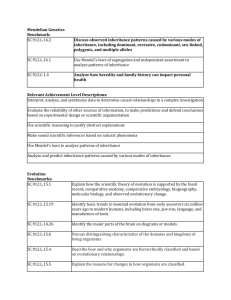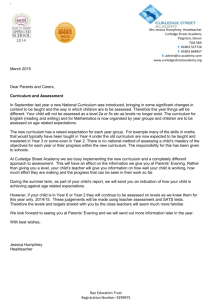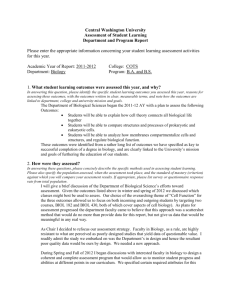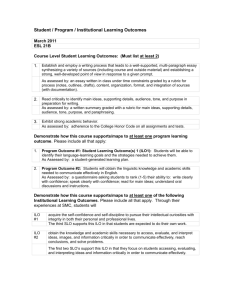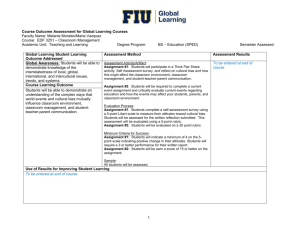Anatomy and Physiology Curriculum Map
advertisement
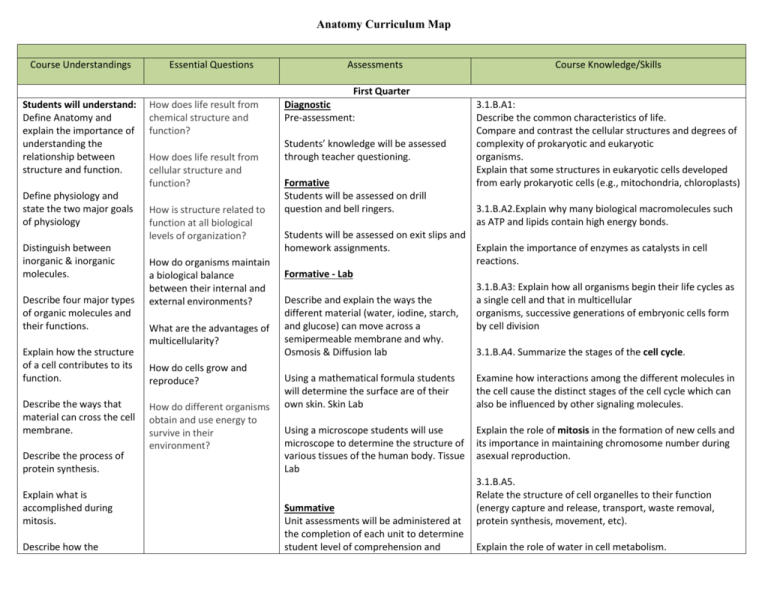
Anatomy Curriculum Map Course Understandings Students will understand: Define Anatomy and explain the importance of understanding the relationship between structure and function. Define physiology and state the two major goals of physiology Distinguish between inorganic & inorganic molecules. Describe four major types of organic molecules and their functions. Explain how the structure of a cell contributes to its function. Describe the ways that material can cross the cell membrane. Describe the process of protein synthesis. Explain what is accomplished during mitosis. Describe how the Essential Questions How does life result from chemical structure and function? How does life result from cellular structure and function? How is structure related to function at all biological levels of organization? How do organisms maintain a biological balance between their internal and external environments? What are the advantages of multicellularity? How do cells grow and reproduce? How do different organisms obtain and use energy to survive in their environment? Assessments First Quarter Diagnostic Pre-assessment: Students’ knowledge will be assessed through teacher questioning. Formative Students will be assessed on drill question and bell ringers. Course Knowledge/Skills 3.1.B.A1: Describe the common characteristics of life. Compare and contrast the cellular structures and degrees of complexity of prokaryotic and eukaryotic organisms. Explain that some structures in eukaryotic cells developed from early prokaryotic cells (e.g., mitochondria, chloroplasts) 3.1.B.A2.Explain why many biological macromolecules such as ATP and lipids contain high energy bonds. Students will be assessed on exit slips and homework assignments. Explain the importance of enzymes as catalysts in cell reactions. Formative - Lab 3.1.B.A3: Explain how all organisms begin their life cycles as Describe and explain the ways the a single cell and that in multicellular different material (water, iodine, starch, organisms, successive generations of embryonic cells form and glucose) can move across a by cell division semipermeable membrane and why. Osmosis & Diffusion lab 3.1.B.A4. Summarize the stages of the cell cycle. Using a mathematical formula students will determine the surface are of their own skin. Skin Lab Examine how interactions among the different molecules in the cell cause the distinct stages of the cell cycle which can also be influenced by other signaling molecules. Using a microscope students will use microscope to determine the structure of various tissues of the human body. Tissue Lab Explain the role of mitosis in the formation of new cells and its importance in maintaining chromosome number during asexual reproduction. Summative Unit assessments will be administered at the completion of each unit to determine student level of comprehension and 3.1.B.A5. Relate the structure of cell organelles to their function (energy capture and release, transport, waste removal, protein synthesis, movement, etc). Explain the role of water in cell metabolism. structure relates to the functions of the following tissues (Epithelial, Connective, Muscle, Nervous, Membranes) Identify the primary function of the skin. Describe the function of the layers and organs associated with the skin. Explain the skin’s role in temperature, regulation and healing. Describe the various diseases associated with the skin. analysis of material. Multiple Choice questions Open ended questioning Analyze charts Explain how the cell membrane functions as a regulatory structure and protective barrier for the cell. Describe transport mechanisms across the plasma membrane. 3.1.B.A7. Analyze the importance of carbon to the structure of biological macromolecules. Compare and contrast the functions and structures of proteins, lipids, carbohydrates, and nucleic acids. Explain the consequences of extreme changes in pH and temperature on cell proteins. 3.1.B.A8.CHANGE AND CONSTANCY Recognize that systems within cells and multicellular organisms interact to maintain homeostasis. PATTERNS Demonstrate the repeating patterns that occur in biological polymers. SYSTEMS Describe how the unique properties of water support life. 3.1.B.B1.Explain the basic process of DNA replication. Describe the basic processes of transcription and translation. 3.1.B.B2. Describe how the process of meiosis results in the formation of haploid gametes and analyze the importance of meiosis in sexual reproduction. Compare and contrast the function of mitosis and meiosis. 3.2.C.A2: Compare the electron configurations for the first twenty elements of the periodic table. Relate the position of an element on the periodic table to its electron configuration and compare its reactivity to the reactivity of other elements in the table. Explain how atoms combine to form compounds through both ionic and covalent bonding. Students will understand: Describe the five functions of the skeleton. Distinguish between the various bone types. Identify the parts of a typical bone. Explain bone formation. Identify the 206 bones of the body. Distinguish between the three types of joints. Indicate the primary functions and the feature of muscle. Identify and describe the microscopic structure of muscle. Explain the sliding filament theory. Compare the differences between muscle types. Indicate the role of ATP. How does life result from cellular structure and function? How is structure related to function at all biological levels of organization? Study island will be used to assess students’ prior knowledge of material. Students’ knowledge will be assessed through teacher questioning. How do organisms maintain a biological balance between their internal and external environments? Formative Students will be assessed on drill question and bell ringers. What are the advantages of multicellularity? Students will be assessed on exit slips and homework assignments. List the functions of the skeletal system. Students will be assessed on section reading passages with questions. Explain the role of calcium in Students will be assessed periodic section quizzes. homeostasis. List and describe the various types of joints. Describe the effects of aging on bones & joints. List the function of the muscular system. And oxygen in a muscular contraction. Describe the microscopic structure of muscle. Identify the major muscles on the basis of location, origin, and insertion. Describe the events that occur in muscular contractions & relaxation. Identify the types of Second Quarter Diagnostic Pre-assessment: Formative - Lab Lab Practical Identify bones of the body. Upper body muscles identification. Lower body muscles identification. Internal organ identification. Summative Unit assessments will be administered at the completion of each unit to determine student level of comprehension and analysis of material. Multiple Choice questions Open ended questioning Analyze charts 3.1.B.A5. Relate the structure of cell organelles to their function with related systems.(energy capture and release, transport, waste removal, protein synthesis, movement, etc). 3.1.B.A8: CHANGE AND CONSTANCY Recognize that systems within cells and multicellular organisms interact to maintain homeostasis with related systems. neurons. Describe the events in a neuron firing. Describe the structural makeup of a neuron, brain, and spinal cord. Explain how a reflex works. Describe the effects of aging on skeletal muscle. List the function of the nervous system. Describe the structures of a neuron. List the division of the nervous system and describe the characteristics of each. Describe a resting potential and explain how action potential is generated and propergated. List the parts of the brain. Describe the effects of aging on the nervous system. Third Quarter Students will understand: Distinguish between the types of glands. How does life result from cellular structure and function? Diagnostic Pre-assessment: Study island will be used to assess students’ prior knowledge of material. Describe a hormone and explain why they only affect certain cells. How is structure related to function at all biological levels of organization? Compare and contrast the ways hormones interact with cells. How do organisms maintain a biological balance between their internal and external environments? Formative Students will be assessed on drill question and bell ringers. What are the advantages of multicellularity? Students will be assessed on exit slips and homework assignments. Compare the means by Students will be assessed on section reading passages with questions. Distinguish between the types of hormone controls of the endocrine glands. Describe the location of the endocrine glands, Students’ knowledge will be assessed through teacher questioning. 3.1.B.A5. Relate the structure of cell organelles to their function with related systems (energy capture and release, transport, waste removal, protein synthesis, movement, etc). 3.1.B.A8: CHANGE AND CONSTANCY Recognize that systems within cells and multicellular organisms interact to maintain homeostasis with related systems. which hormones they produces and the action of that hormone. which the nervous system and endocrine system regulate body function. Students will be assessed periodic section quizzes. Identify the functions of blood. Describe how hormones interact on the basis of their chemical structure. Formative - Lab Brain Practical – Identify the different parts of the brain. Describe the three methods of regulating hormones. Cardiovascular- Students will determine their own cardio output & blood pressure based on changes of gravity and physical activity. Identify the properties of blood. Describe and state the functions of the various parts of blood. Explain blood clot formation. Identify the location and general features of the heart. Define cardiac output and describe how it is regulated. For each major hormone describe the endocrine gland from which it is secreted, its target tissue, the response of the target tissue and the means by which its secretion is regulated. Describe the major agerelates changes that occur in the endocrine system. State the function of blood. Distinguish between the types of blood vessels on the basis of their structure and function. Describe the factors influencing blood pressure. List the components of blood. Explain the formation & function of the platelet plug & clot. Explain the basis of ABO & Rh incompatibilities. List the major function of the heart. Describe the flow of blood through the heart and name each of the chambers and Summative Unit assessments will be administered at the completion of each unit to determine student level of comprehension and analysis of material. Multiple Choice questions Open ended questioning Analyze charts structures through which blood passes. Describe the characteristics of action potential in cardiac muscle. List the major age-relates changes that affect the heart. Fourth Quarter Students will understand: Identify the function of the lymphatic network. Describe the pathway of lymph by identifying the structures it passes through. How does life result from cellular structure and function? How is structure related to function at all biological levels of organization? Diagnostic Pre-assessment: Study island will be used to assess students’ prior knowledge of material. Students’ knowledge will be assessed through teacher questioning. How do organisms maintain a biological balance between their internal and external environments? Formative Students will be assessed on drill question and bell ringers. What are the advantages of multicellularity? Students will be assessed on exit slips and homework assignments. Describe the functions of the lymphatic system. Students will be assessed on section reading passages with questions. Define innate immunity and describe the cells and chemical mediators involved. Students will be assessed periodic section quizzes. Identify the organs of the respiratory system. Describe the origin, development, activation, & proliferation of lymphocytes. Identify the two divisions of the digestive system. Define the six process of Describe how aging affects Respiratory lab – Students will determine their own vital capacity, compare capacities between male, female, athletes, & non-athletes. From the data make comparisons and assumptions for the differences. Distinguish between specific and non-specific immunity. Describe the process of cell mediated and humoral immunity. Identify the main function of the respiratory system. Distinguish between pulmonary ventilation, external respiration, internal respiration. Formative - Lab 3.1.B.A5. Relate the structure of cell organelles to their function with related systems (energy capture and release, transport, waste removal, protein synthesis, movement, etc). 3.1.B.A8: CHANGE AND CONSTANCY Recognize that systems within cells and multicellular organisms interact to maintain homeostasis with related systems. digestion. Identify the organs associated with the digestive system. Describe the effects of aging on the digestive system. Identify the function of the excretory system. Identify the structural parts of the kidneys. Describe the process that regulates kidney function. Distinguish between prenatal and postnatal development. Describe the process of fertilization. Explain the function of the placenta. Describe the event during birth. Describe the stages of life. the lymphatic system & immunity. Describe the function of the respiratory system. Explain how contractions of the muscles of respiration causes changes in thoracic volume during breathing. Explain the factors that effects gas movement through the respiratory membrane. Explain how alterations in blood pH, carbon dioxide & oxygen levels affect ventilation. Describe the effects of aging on the respiratory system. List the major functions of the digestive system. Describe & outline all the organs associated in the digestive process. Describe the effects of aging on the digestive system. List the major functions of the urinary system. List & describe the structures that make up the urinary system. Identify the principal factors Digestive lab- using mypyramid.gov web site students will determine their caloric, fiber, protein, fat intake for a day. Urinalysis lab- Students will preforms a serious of tests to determine if their own urinalysis. Summative Unit assessments will be administered at the completion of each unit to determine student level of comprehension and analysis of material. Multiple Choice questions Open ended questioning Analyze charts the influence filtration pressure and explain how they affect the rate of filtration pressure. List & give the function of the nephron. List the prenatal periods and state the major developmental events associated with each. Explain the events that occur during parturition. List the stages of life, describe the major events that are associated with each stage. Describe the changes that occur during the aging process. Describe the process of aging.
